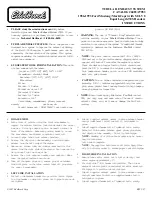
Tow/Haul is designed to be most effective when the
vehicle and trailer combined weight is at least 75 percent
of the vehicle’s Gross Combined Weight Rating (GCWR).
See “Weight of the Trailer” later in the section. Tow/Haul
is most useful under the following driving conditions:
•
When pulling a heavy trailer or a large or heavy load
through rolling terrain.
•
When pulling a heavy trailer or a large or heavy load
in stop and go traffic.
•
When pulling a heavy trailer or a large or heavy load
in busy parking lots where improved low speed
control of the vehicle is desired.
Operating the vehicle in Tow/Haul when lightly loaded
or with no trailer at all will not cause damage. However,
there is no benefit to the selection of Tow/Haul when
the vehicle is unloaded. Such a selection when unloaded
may result in unpleasant engine and transmission
driving characteristics and reduced fuel economy.
Tow/Haul is recommended only when pulling a heavy
trailer or a large or heavy load.
Weight of the Trailer
How heavy can a trailer safely be?
It depends on how you plan to use your rig.
For example, speed, altitude, road grades, outside
temperature and how much your vehicle is used to pull
a trailer are all important. It can also depend on any
special equipment that you have on your vehicle,
and the amount of tongue weight the vehicle can carry.
See “Weight of the Trailer Tongue” later in this section
for more information.
Maximum trailer weight is calculated assuming only the
driver is in the tow vehicle and it has all the required
trailering equipment. The weight of additional optional
equipment, passengers and cargo in the tow vehicle
must be subtracted from the maximum trailer weight.
4-57
Summary of Contents for 2008 Silverado 1500 Pickup
Page 20: ...Put someone on it Get it up to speed Then stop the vehicle The rider does not stop 1 16 ...
Page 94: ... NOTES 1 90 ...
Page 178: ... NOTES 2 84 ...
Page 181: ... NOTES 3 3 ...
Page 406: ... NOTES 4 94 ...
Page 542: ... NOTES 5 136 ...
















































